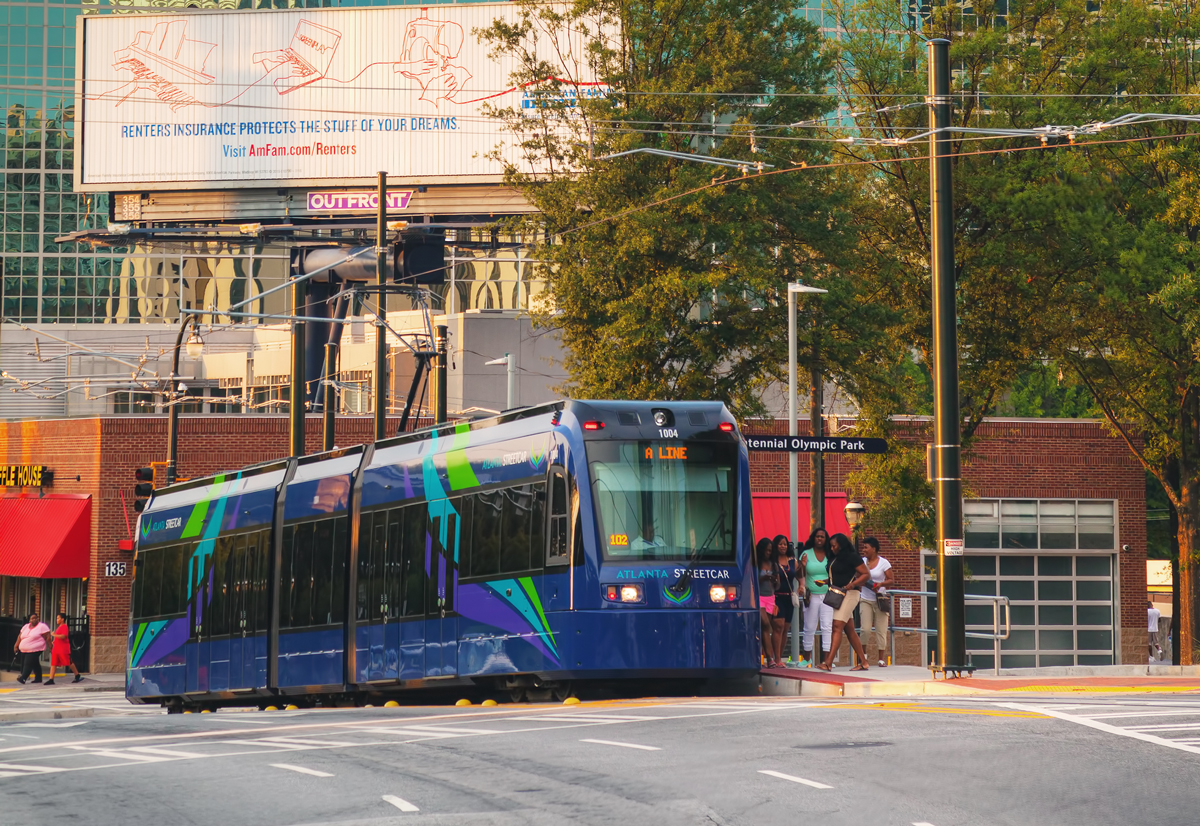
Photograph by AndreyKrav via iStock Editorial / Getty Images Plus
Back in November, voters overwhelmingly approved a sales tax increase to fund transit expansion in the City of Atlanta. MARTA just released its ideal expansion plans, which include bus rapid transit crisscrossing the city, late night and weekend bus service, and 21 miles of light rail. The plan calls for light rail on the BeltLine, which was ranked the highest during the public input process after expanded bus service. But there is a fatal flaw: the light rail infrastructure goes through one of the most congested parts of town, the downtown path of the Atlanta Streetcar.

Courtesy of MARTA
Building a multi-billion-dollar light rail system around a bottleneck will choke the entire network. Trains can only go as fast as the slowest segment of the route. Currently, whenever a bad parking job interferes with the Streetcar tracks, the whole route is paralyzed for hours at time. Routing the new rail line through the Atlanta Streetcar will end up straining passengers on a daily basis. Crawling trains are not only frustrating for passengers, they are also expensive to operate. MARTA would have to run many more $4-million vehicles in order to maintain short headways (or time between vehicles).
To relegate expensive transit infrastructure in mixed traffic means that trains will only go as fast as the cars around them. It’s profoundly unfair that transit vehicles, which can carry a hundred times more people than private cars, can get stuck in the same congestion. And it doesn’t make economic sense. As Georgia Tech professor Kari Watkins says: “When buses and trains are mixed in with general traffic, there is no incentive for people to chose transit.” And if they instead opt to drive themselves, streets will get more congested, air more polluted, and intersections more deadly.
While doing my Ph.D. at Georgia Tech, I spent three weeks in the command center for a project on streetcar bunching—when delays accumulate and cause gaps in service. I know first hand that the Atlanta Streetcar is staffed with dedicated public servants who are doing a fantastic job. The problem with the Streetcar was never its people, or even its length, but its location. The route will never be able to flow freely without closing its single lane to cars altogether. Here’s the hiccup: Edgewood is an entrance to Interstate I75-85. Unless GDOT plans to close down the entrance, the Atlanta Streetcar’s route will remain clogged forever.
Map: Planned light rail expansion by MARTA (orange) and proposed alternative (purple) with infill stations at Boone and Krog (yellow) and current MARTA heavy rail network (Clifton Corridor and bus rapid transit not included).
Almost exactly a year ago, I urged MARTA and City of Atlanta officials to strengthen the existing transit network and maximize connections. But the new plan proposed by MARTA makes it virtually impossible for people on the Westside to access the Northeast BeltLine and people on the Eastside to access the Southwest BeltLine. The planned route (the orange line in map above) only touches the East-West Green and Blue lines at one point, Dome/GWCC/Phillips Arena/CNN Center, just one stop away from the central hub at Five Points. Instead of running diagonal, transit should be expanded as a grid, allowing any trip to be made with just one transfer.
I believe we should extend BeltLine rail toward neighborhoods that currently don’t have access to high-capacity transit: Reynoldstown and Cabbagetown on the Northeast corridor, and English Avenue, Vine City, and Washington Park on the Southwest corridor (the purple line in map above). New infill stations (yellow dots) should be added on Joseph E. Boone Boulevard and Krog Street to connect the Green and Blue Lines with Lindbergh and Oakland City on the North-South Red and Gold Lines.
Focusing transit on the BeltLine would ensure that new transit infrastructure get the space needed to be fast, efficient, and attractive. Building Infill Stations would strengthen MARTA’s core network, allowing transit riders to access many more destinations. The proposed plan would create redundancy (the capacity to use multiple routes at once), which makes the entire network more resilient to single-tracking (closing tracks for maintenance) and catastrophic events, like say a flaming interstate bridge collapse.
Infill stations at Krog Street and Boone Boulevard were both in the project list approved by City of Atlanta voters along with dozens of other projects that won’t fit in the $2.5 billion budget. Building the two infill stations is expected to cost $80 and $40 million, respectively, according to a document obtained from the City of Atlanta. That’s not much compared to the $300 million to build and $170 million to operate (over 30 years) the link between Northeast and Southwest BeltLine. The Southwest rail line could even be extended to Bankhead Station and connect with the crosstown route on Donald Lee Hollowell/North Avenue, although the cost is still unknown.
Over the next several months, MARTA and the City of Atlanta will collect feedback on the proposed plan. There is no rush to start building everything at once because Atlanta probably won’t get much support form the federal government anytime soon. TIGER grants, the main federal program funding transit, have been transformed to favor rural infrastructure, and Politico reported this month that the Trump administration is looking to reduce the share of public transit in the approved budget.
The Atlanta Streetcar was built on the premise of being the first link to an extensive transit network. Three years later, we must recognize that it cannot serve as the foundation for expansion. Let’s call the Atlanta Streetcar a fair price for a lesson learned and build future transit infrastructure with MARTA’s existing heavy rail network as the backbone.
Dr. Simon J. Berrebi is a postdoctoral fellow at Georgia Tech and an entrepreneur in transit operations. Previously he founded and led the MARTA Army, a nonprofit dedicated to improving the transit ridership experience in the Atlanta region.














